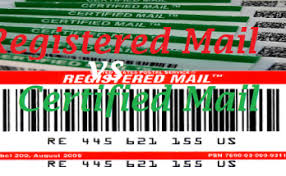While most things these days can be sent over the internet, there are still some items that must be mailed the old fashioned way: legal documents, checks, and original documents, to name a few. If you need to mail something that you can’t necessarily replace, certified mail may be for you. There are, however, different options when sending important documents and heirlooms. Before you decide between sending certified mail, you should know the difference between them as well as the benefits involved.
Registered Mail
When sending something valuable or irreplaceable, many people chose the United States Postal Service’s (USPS) original secured mail, registered mail. With registered mail, you pay by the weight of the package and can obtain up to $50,000 in insurance against loss or damage. Registered mail creates additional security and protection. While being transported, your package stays in a safe place like a locked cage, safe, or container. Every time your package changes hands, there is a signature required to show exactly where your item is along the way.
Certified Mail
USPS created a different form of registered mail that allows the transport of essential packages, but at a lower cost than regular registered mail. Certified mail isn’t locked away during transportation and doesn’t have the same insurance options. It does, however, come with a guarantee that it will be delivered. If the recipient claims the package didn’t arrive, you can look at the online tracking to show otherwise.
Benefits
Both businesses and private individuals can benefit from using registered or certified mail options. Here are some of the top benefits you can enjoy.
1. Proof of Mailing
Many legal documents and checks need to be sent by a specific date. Sending these documents via regular mail offers no evidence that it was sent. If the package is delayed, there is no proof that it was sent and you could be subject to late fees or other penalties. If you need to send an original document or check, communicating electronically won’t suffice.
2. Tracking
While waiting for the package to arrive, your recipient can track its location. While you can often add a tracking number to other types of mail, it comes at an additional cost.
3. Proof of delivery
Since both certified and registered mail requires a signature to be delivered, you can not only assure that your package makes it safely but can prove that it did arrive. You also know exactly who signed for it. As with tracking, proof of delivery may be available at an extra cost
4. Print labels from home
You may remember a day when sending certified or registered mail required a long wait in line at the post office. If you don’t have much time or live far away from a post office, this kind of mail may seem like an unattainable option. Currently, you can print labels from your own computer when and where it is convenient for you.
5. Cheaper than private carriers
While several private carriers can offer similar services, they often come at an extra price. Even if your company has a deal with FedEx, UPS, or another service, you’ll find that most often the post office is still the least expensive.
6. Extra protection
Sadly, everyone knows someone who has had packages stolen from their porch. Both certified and registered mail keeps a record of everyone who handles your package until it is delivered. The chances of your parcel being lost or stolen are extremely low. Of course, the added layer of protection may slow down the delivery time. Certified mail is faster as it ships the same as first-class or priority mail. Registered mail is often slower due to the added layers of protection.
Conclusion
If you have something important to send, consider send a letter online. Both of these services add an additional layer of protection and tracking over regular mail. Certified mail is a good choice when you want to save money but still require security. With the ease of access and major benefits associated with certified and registered mail, there is no reason not to give it a try.
![[Jcount.com]](https://www.jcount.com/wp-content/uploads/2014/08/jcount150X50.png)
![[Jcount.com]](https://www.jcount.com/wp-content/uploads/2014/08/jcountstartupslogo1.png)





